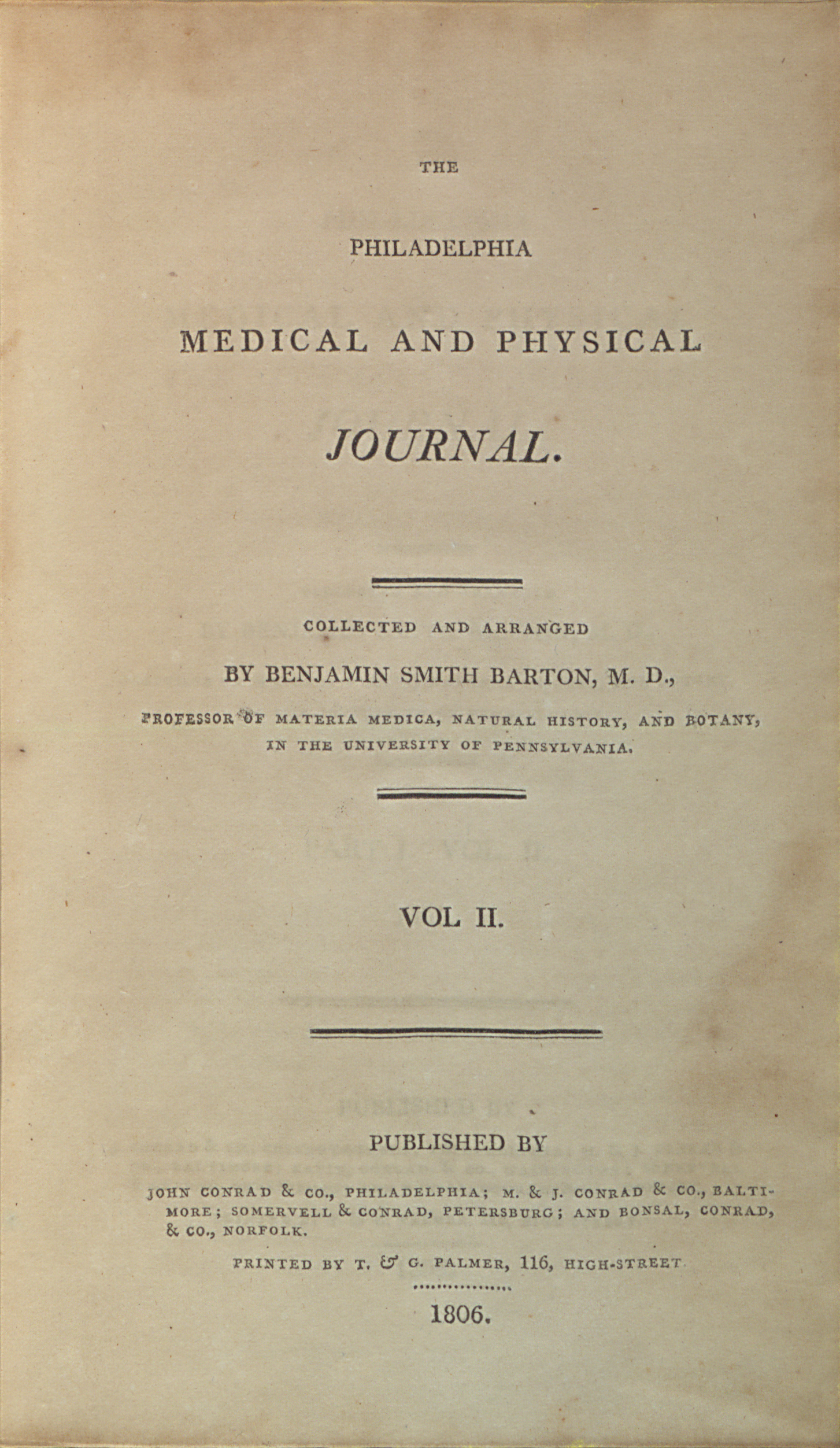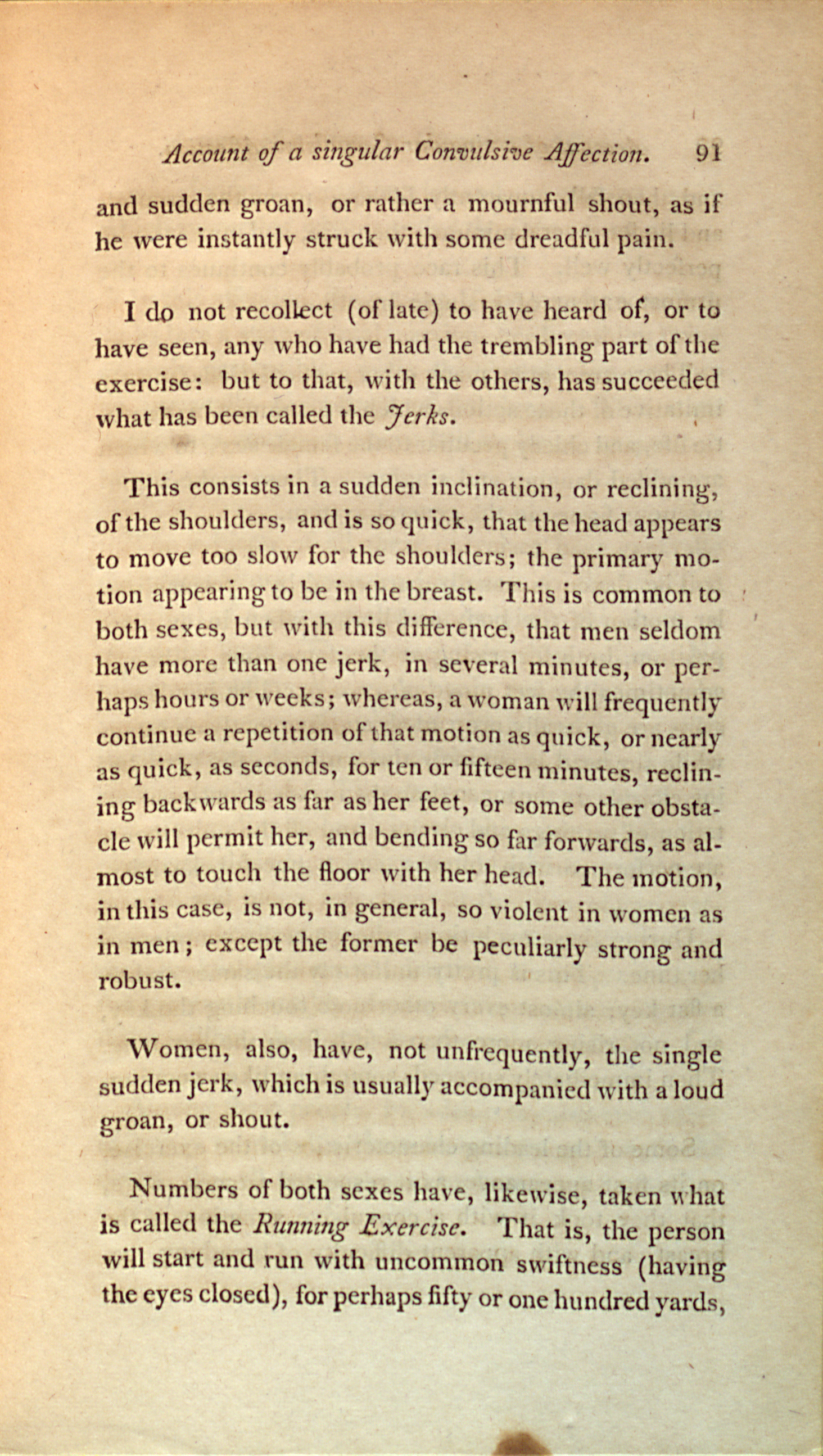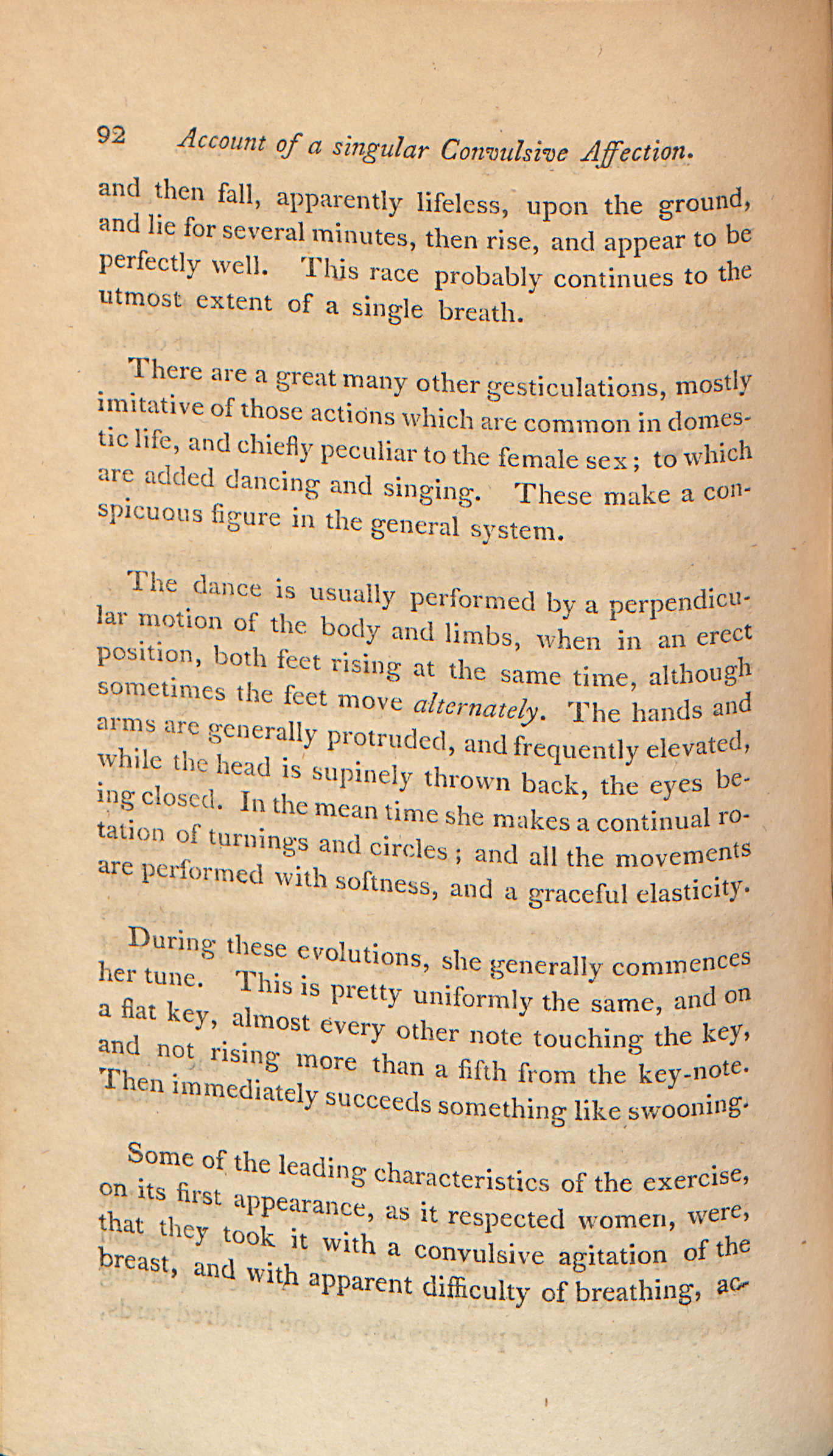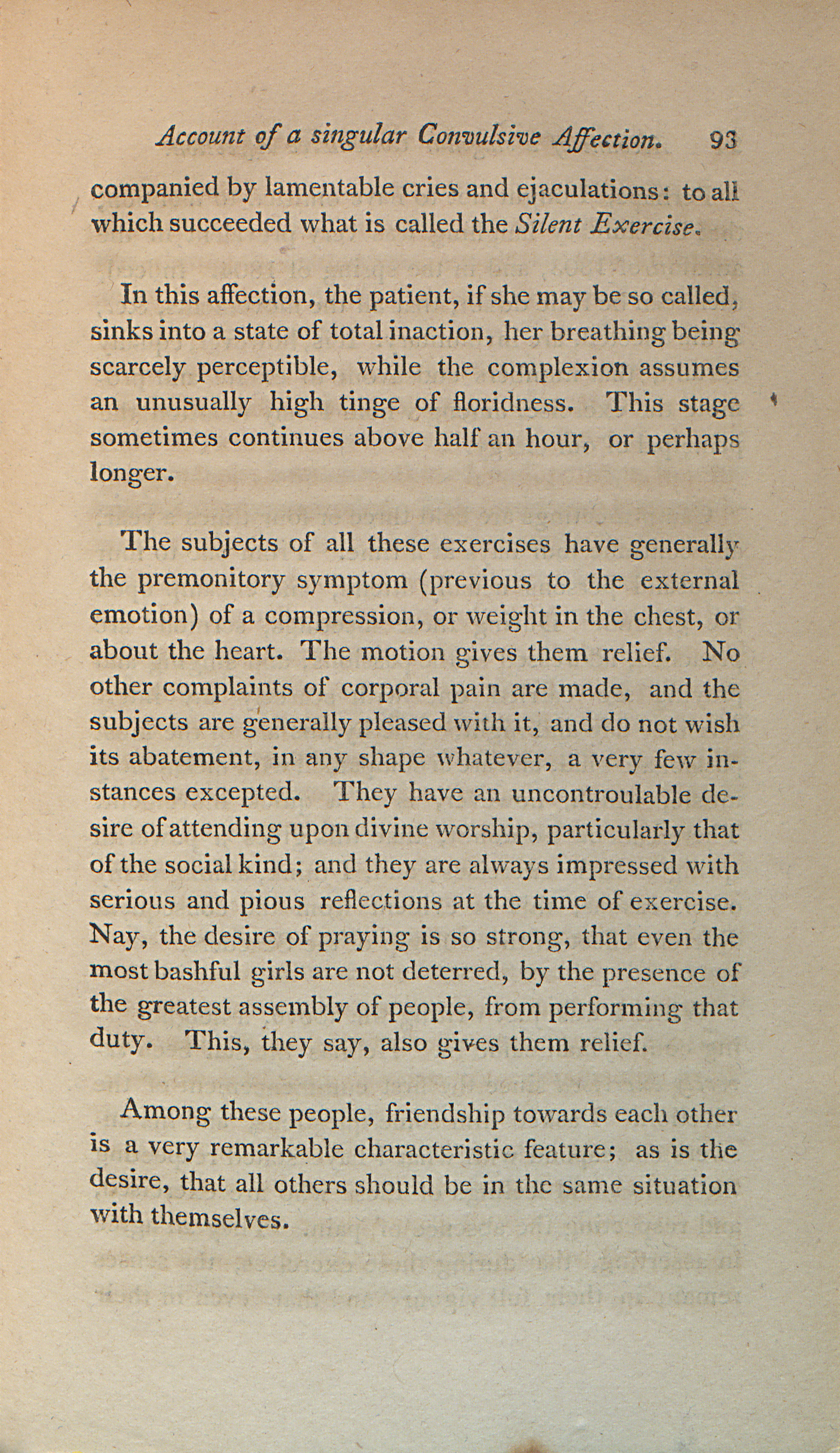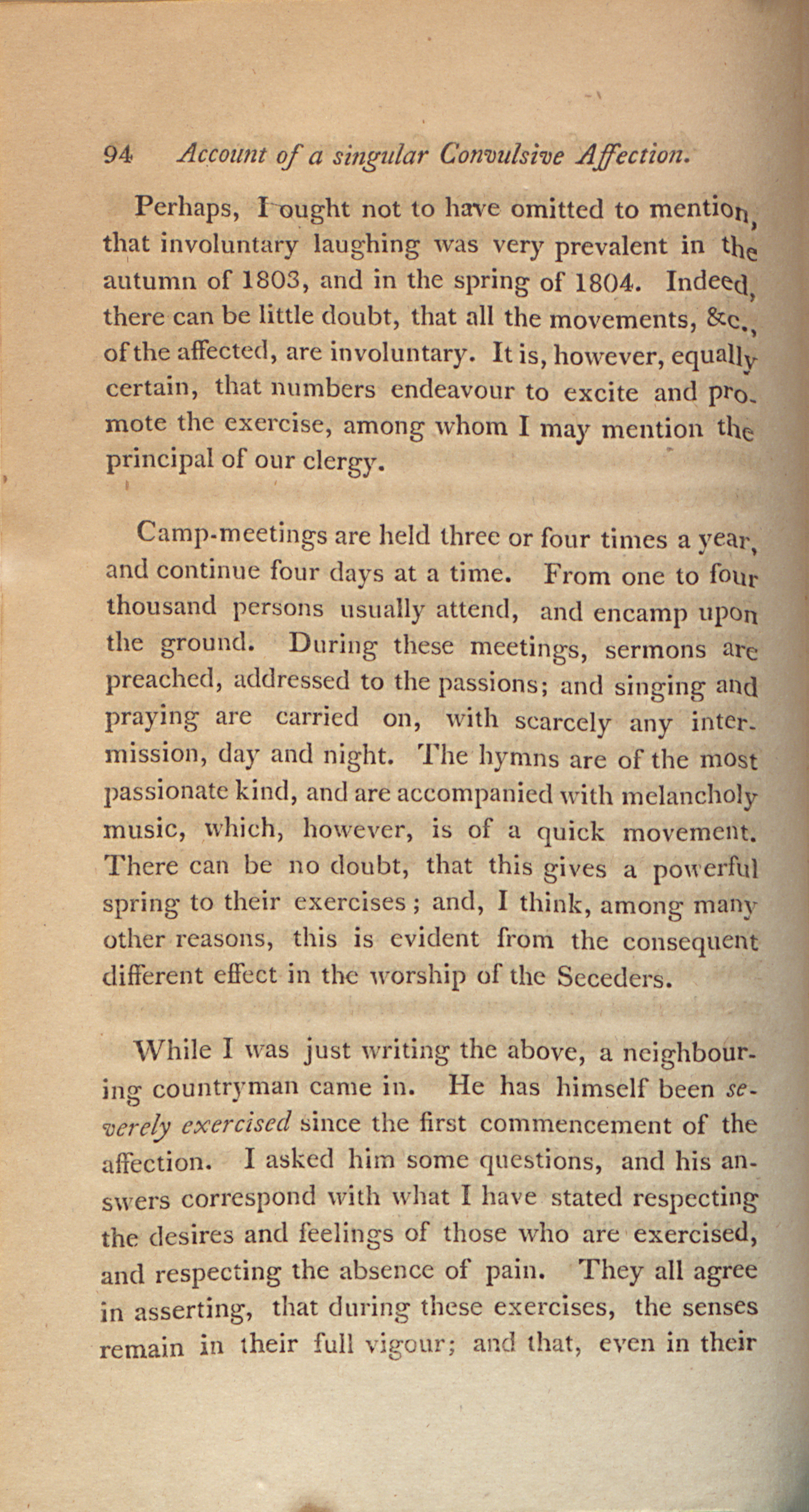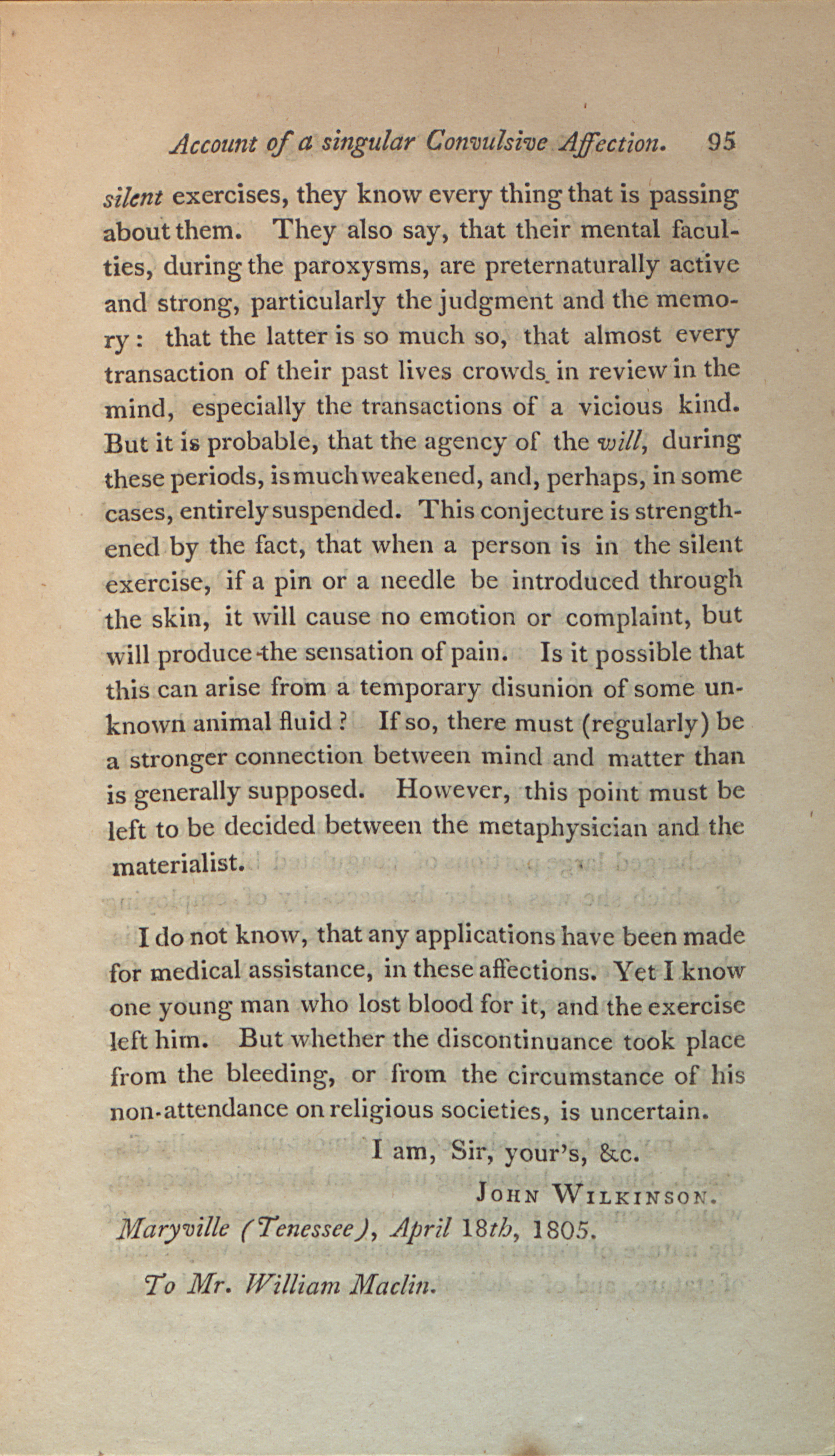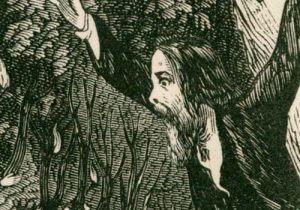Published in a prominent Philadelphia medical journal, John Wilkinson’s letter to Tennessee secretary of state William Maclin is the most detailed and comprehensive surviving account of the bodily exercises in east Tennessee. As a member of Gideon Blackburn’s congregation in Maryville, Wilkinson had witnessed the initial outbreak of jerking exercise in 1803. Two years later, he encountered Felix Robertson’s Essay of Chorea Sancti Viti, in which the aspiring Nashville physician argued that the somatic exercises of the Great Revival were actually an epidemic nervous disorder. Wilkinson is less confident in his philosophical speculations, but he does provide valuable descriptions of the various forms the bodily agitations assumed. Wilkinson’s report is especially noteworthy for his attempts to establish basic demographic statistics and interest in the ways men and women experienced the jerks differently. Wilkinson sent his reflections on the bodily exercises to William Maclin, who appears to have forwarded the letter to Felix Robertson for publication. Click here for Robertson’s Essay and here to examine the complete issue of the Philadelphia Medical and Physical Journal.
XV. Account of a singular Convulsive Affection, which prevai!s in the State of Tenessee, and in other parts of the United-States. Communicated to the EDITOR by FELIX ROBERTSON, M. D., of Nashville, in Tenessee.
BELIEVING that the gentlemen (Mr. Maclin and Mr. Wilkinson) to whose politeness and attention I am indebted for the account of the rise and progress of the Epidemic Chorea, will have no objection to the publication of it, I send the paper, with permission, if you deem it worthy of the place, to insert it in one of the numbers of your Journal. For several reasons, I have been much more concise in my Inaugural Dissertation, on this subject, than I could have wished; and I doubt not that those who have never seen the disease, may desire to be furnished with a more minute account of it, than that which I have given. I am, &c.
FELIX ROBERTSON. To Dr. Barton.
Philadelphia, May 30th, 1805.
It is with extreme diffidence that, according to your desire, I attempt to give a history of the Rise and Progress (in this place) of the affection which your friend and correspondent, Dr. Robertson, terms Chorea, or St. Vitus’s Dance. This diffidence arises from two circumstances, among, perhaps, many others: viz.
First, at this time, I have not sufficient leisure to reflect on, and to examine the subject; and Secondly (which is a more substantial reason), I really doubt whether I know any thing as to the philosophy of the subject, without which a perfect history of the affection ought not to be expected; although I believe that (from every information that I have been able to collect) it is more prevalent here, and in the neighbourhood, than it is, or ever was, in any part of the world; and although I have (possessing the opportunity) paid attention to it, from its first commencement to the present time. However, so far as I shall attempt to proceed in the inquiry, I will endeavour to be as impartial a relator as possible.
This disease made its appearance, in this place, early in the summer of 1803, and increased in its effects with astonishing rapidity, until the latter end of that season. Since this period, the average number of subjects, each season, has not, I think, very greatly differed from what it was at that time, there being but little difference in the summer and the winter months. So far from being considered as a disease, either contagious or epidemical, it has been, and still continues to be, recognized, generally, as a favourable religious visitation from the Deity, and is designated under the general appellation of the Religious Exercise.
The subjects of this exercise are mostly of the PRESBYTERIAN sect of religionists, and are very numerous in this country, there being four congregations. And of these, within such ages as are usually subject to its influence, I am satisfied, that one fourth, if not one third, or one half of them, are, and have been affected, under some one modification or other of the exercise.
Some very BAPTISTS have also been exercised; but it is remarkable, that I do not recollect to have heard of a single case among the sect denominated SECEDERS having taken it at their religious meetings, although they are very considerable in numbers; nor do I remember a single instance of any person having taken it, except those who attended some religious meeting, or society; and almost everyone has, in the first instance, taken it in such meetings or society.
I have known some persons as young as six or seven years of age, and others, I think, upwards of sixty, affected: but a great majority are from the age of twelve to twenty, or twenty-five, and of the affected, there are more females than males. There is scarcely one girl in ten, between the age of twelve and twenty, that has not had, or now has, the exercise.
Of those persons who attend religious worship, and of both sexes, the affected are very generally such as are of the most vigorous and healthy constitution.
I do not recollect to have heard of any persons taking it in their sleep. It has intermissions, which, however, are not regular. It does not appear with any malignant exacerbations. Some continue to have it from the first commencement of the affection.
The intermissions, in general, continue as long as the person is absent from worship. To this rule, however, there are exceptions; for the affection frequently recurs on a surprize, from serious reflection; from depression of spirits; from sorrow, or from grief.
A discontinuance of the affection, for weeks or months, is frequent; and, in some instances, there is a total cessation of the affection; while new cases are as frequently recurring.
The affected generally continue healthy; except in some few instances, where the affection, having been more constant and violent, appears to have weakened the person, in some measure.
The paroxyism, if it may be so termed, continues from half an hour to an hour, or upwards; or, perhaps, as long as the meeting, which they are at, continues: but during such meeting the person will sometimes have only a single motion, or, at least, very few of them.
In respect to the mode of action or gesture, this has varied, in general, in some degree from what it was at the first appearance of the affection. Indeed, at all times since, it has been almost infinitely different, and varied in different persons, and even in the same individual. It would be impossible to give a correct historical account of the varieties of the affection. A few of its most prominent or distinguishing features is all that I can attempt to delineate, at present.
Upon the first appearance of the affection, the agitations of the men were different from those of the women. The former were sometimes seized with a trembling, so violent as to make the seats or pews, at some distance, shake. This symptom was frequently followed by (apparently) the most painful wreathings of the body and limbs, with a disposition, or inclination, to tumble about on the ground. At other times, the affected would make one or several perpendicular vaults, to the height (or perhaps a greater height) that he naturally could by a voluntary exertion. These actions were frequently accompanied by a deep, loud, and sudden groan, or rather a mournful shout, as if he were instantly struck with some dreadful pain.
I do not recollect (of late) to have heard of, or to have seen, any who have had the trembling part of the exercise: but to that, with the others, has succeeded what has been called the Jerks.
This consists in a sudden inclination, or reclining, of the shoulders, and is so quick, that the head appears to move too slow for the shoulders; the primary motion appearing to be in the breast. This is common to both sexes, but with this difference, that men seldom have more than one jerk, in several minutes, or perhaps hours or weeks; whereas, a woman will frequently continue a repetition of that motion as quick, or nearly as quick, as seconds, for ten or fifteen minutes, reclining backwards as far as her feet, or some other obstacle will permit her, and bending so far forwards, as almost to touch the floor with her head. The motion, in this case, is not, in general, so violent in women as in men; except the former be peculiarly strong and robust.
Women, also, have, not unfrequently, the single sudden jerk, which is usually accompanied with a loud groan, or shout.
Numbers of both sexes have, likewise, taken what is called the Running Exercise. That is, the person will start and run with uncommon swiftness (having the eyes closed), for perhaps fifty or one hundred yards, and then fall, apparently lifeless, upon the ground, and lie for several minutes, then rise, and appear to be perfectly well. This race probably continues to the utmost extent of a single breath.
There are a great many other gesticulations, mostly imitative of those actions which are common in domestic life, and chiefly peculiar to the female sex; to which are added dancing and singing. These make a conspicuous figure in the general system.
The dance is usually performed by a perpendicular motion of the body and limbs, when in an erect position, both feet rising at the same time, although sometimes the feet move alternately. The hands and arms are generally protruded, and frequently elevated, while the head is supinely thrown back, the eyes being closed. In the mean time she makes a continual rotation of turnings and circles; and all the movements are performed with softness, and a graceful elasticity.
During these evolutions, she generally commences her tune. This is pretty uniformly the same, and on a flat key, almost every other note touching the key, and not rising more than a fifth from the key-note. Then immediately succeeds something like swooning.
Some of the leading characteristics of the exercise, on its first appearance, as it respected women, were, that they took it with a convulsive agitation of the breast, and with apparent difficult of breathing, accompanied by lamentable cries and ejaculations: to all which succeeded what is called the Silent Exercise.
In this affection, the patient, if she may be so called, sinks into a state of total inaction, her breathing being scarcely perceptible, while the complexion assumes an unusually high tinge of floridness. This stage sometimes continues above half an hour, or perhaps longer.
The subjects of all these exercises have generally the premonitory symptom (previous to the external emotion) of a compression, or weight in the chest, or about the heart. The motion gives them relief. No other complaints of corporal pain are made, and the subjects are generally pleased with it, and do not wish its abatement, in any shape whatever, a very few instances excepted. They have an uncontroulable desire of attending upon the divine worship, particularly that of the social kind; and they are always impressed with serious and pious reflections at the time of exercise. Nay, the desire of praying is so strong, that even the most bashful girls are not deterred, by the presence of the greatest assembly of people, from performing that duty. This, they say, also gives them relief.
Among these people, friendship towards each other is a very remarkable characteristic feature; as is the desire, that all others should be in the same situation with themselves.
Perhaps, I ought not to have omitted to mention, that involuntary laughing was very prevalent in the autumn of 1803, and in the spring of 1804. Indeed, there can be little doubt, that all the movements, &c., of the affected, are involuntary. It is, however, equally certain, that numbers endeavour to excite and promote the exercise, among whom I rnay mention the principal of our clergy.
Camp-meetings are held three or four times a year, and continue four days at a time. From one to four thousand persons usually attend, and encamp upon the ground. During these meetings, sermons are preached, addressed to the passions; and singing and praying are carried on, with scarcely any intermission, day and night. The hymns are of the most passionate kind, and are accompanied with melancholy music, which, however, is of a quick movement. There can be no doubt; that this gives a powerful spring to their exercises; and I think, among many other reasons, this is evident from the consequent different effect in the worship of the Seceders.
While I was just writing the above, a neighbouring countryman came in. He has himself been severely exercised since the first commencement of the affection. I asked him some questions, and his answers correspond with what I have stated respecting the desires and feelings of those who are exercised, and respecting the absence of pain. They all agree in asserting, that during these exercises, the senses remain in their full vigour; and that, even in their silent exercises, they know every thing that is passing about them. They also say, that their mental faculties, during the paroxysms, are preternaturally active and strong, particularly the judgment and the memory: that the latter is so much so, that almost every transaction of their past lives crowds in review in the mind, especially the transactions of a vicious kind. But it is probable, that the agency of the will, during these periods, is much weakened, and, perhaps, in some cases, entirely suspended. This conjecture is strengthened by the fact, that when a person is in the silent exercise, if a pin or a needle be introduced through the skin, it will cause no emotion or complaint, but will produce the sensation of pain. Is it possible that this can arise from a temporary disunion of some unknown animal fluid? If so, there must (regularly) be a stronger connection between mind and matter than is generally supposed. However, this point must be left to be decided between the metaphysician and the materialist.
I do not know, that any applications have been made for medical assistance, in these affections. Yet I know one young man who lost blood for it, and the exercise left him. But whether the discontinuance took place from the bleeding, or from the circumstance of his non-attendance on religious societies, is uncertain.
I am, Sir, your’s, &c.
JOHN WILKINSON. Maryville (Tenessee), April 18th, 1805.
Here you can create the content that will be used within the module.
Source
John Wilkinson to William Maclin, April 18, 1805, in Felix Robertson, “Account of a Singular Convulsive Affection which Prevails in the State of Tennessee, and Other Places of the United States,” in Benjamin Smith Barton, coll., Philadelphia Medical and Physical Journal, part 1, vol. 2 (Philadelphia, 1805), 86-95.
